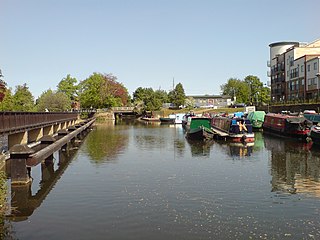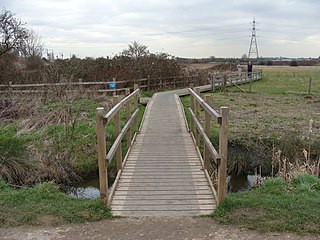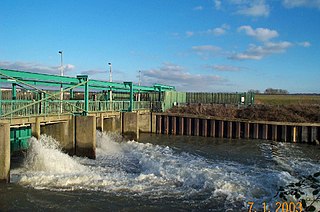
Chingford is a town in east London, England, within the ceremonial county of Greater London and the historic county of Essex. The ancient woodland, Epping Forest forms a border to the north and east, the Lea Valley reservoirs to the West and the A406 North Circular Road to the south. Chingford is situated 8.6 miles (13.8 km) north-east of Charing Cross, with Waltham Abbey to the north, Woodford Green and Buckhurst Hill to the east, Walthamstow to the south, and Edmonton and Enfield to the west. The town contains the areas of Chingford Green, Chingford Hatch, Chingford Mount, Friday Hill, Hale End, Highams Park, and South Chingford, and had a population of 66,211 at the 2011 census.

Walthamstow is a large town in North East London, England, within the ceremonial county of Greater London and the ancient county of Essex. Situated 7+1⁄2 miles northeast of Charing Cross, the town borders Chingford to the north, Snaresbrook and South Woodford to the east, Leyton and Leytonstone to the south, and Tottenham to the west. At the 2011 census, the town had a population of approximately 109,424.

The London Borough of Waltham Forest is a London borough in north-east London, England. Its population is estimated to be 276,983 in 2019. It borders five other London boroughs: Enfield to the north-west, Haringey to the west, Hackney to the south-west, Newham to the south-east and Redbridge to the east, as well as the non-metropolitan county of Essex to the north.

The River Lea is in South East England. It originates in Bedfordshire, in the Chiltern Hills, and flows southeast through Hertfordshire, along the Essex border and into Greater London, to meet the River Thames at Bow Creek. It is one of the largest rivers in London and the easternmost major tributary of the Thames.
Sewardstone is a hamlet in the civil parish of Waltham Abbey, in the Epping Forest District of Essex, England. It is 11.6 miles north-northeast of Central London and is in the London commuter belt. In 2018 it had an estimated population of 1128.

Walthamstow Marshes, is a 36.7 hectare biological Site of Special Scientific Interest in Walthamstow in the London Borough of Waltham Forest. It was once an area of lammas land – common land used for growing crops and grazing cattle.
The Lea Valley, the valley of the River Lea, has been used as a transport corridor, a source of sand and gravel, an industrial area, a water supply for London, and a recreational area. The London 2012 Summer Olympics were based in Stratford, in the Lower Lea Valley. It is important for London's water supply, as the source of the water transported by the New River aqueduct, but also as the location for the Lee Valley Reservoir Chain, stretching from Enfield through Tottenham and Walthamstow.

The William Girling Reservoir is located in the London Borough of Enfield and is part of the Lee Valley Reservoir Chain that supplies London with drinking water. It is named after William Girling OBE, a chairman of the Metropolitan Water Board (MWB). The reservoir and the nearby King George V Reservoir are known collectively as the Chingford Reservoirs. The storage reservoir, which is owned by Thames Water, is bordered by Chingford to the east and Ponders End and Edmonton to the west, and covers 334 acres with a perimeter of 3.5 miles (5.6 km). There is no public access.

The King George V Reservoir, also known as King George's Reservoir, is located in the London Borough of Enfield and is part of the Lee Valley Reservoir Chain that supplies London with drinking water. The storage reservoir is bordered by Sewardstone and Chingford to the east and Brimsdown and Ponders End to the west, and covers 420 acres, making it the largest in London. The reservoir and the nearby William Girling Reservoir are known collectively as the Chingford Reservoirs, and are owned and managed by Thames Water.
London's water supply infrastructure has developed over the centuries in line with the expansion of London. For much of London's history, private companies supplied fresh water to various parts of London from wells, the River Thames and the River Lea. Further demand prompted new conduits and sources, particularly when the Agricultural and Industrial Revolution caused a boom in London's population and housing.

The Lea Valley Walk is a 50-mile (80 km) long-distance path located between Leagrave, the source of the River Lea near Luton, and the Thames, at Limehouse Basin, Limehouse, east London. From its source much of the walk is rural. At Hertford the path follows the towpath of the River Lee Navigation, and it becomes increasingly urbanised as it approaches London. The walk was opened in 1993 and is waymarked throughout using a swan logo.

The Lee Flood Relief Channel (FRC) is located in the Lea Valley and flows between Ware, Hertfordshire, and Stratford, east London. Work started on the channel in 1947 following major flooding and it was fully operational by 1976. The channel incorporates existing watercourses, lakes, and new channels. Water from the channel feeds the Lee Valley Reservoir Chain.

Lockwood Reservoir is located in Walthamstow in the London Borough of Waltham Forest. It is one of the ten Walthamstow Reservoirs, which are part of the Lee Valley Reservoir Chain. The reservoirs supply drinking water to London and are owned by Thames Water.
High Maynard Reservoir is located in Walthamstow in the London Borough of Waltham Forest. The storage reservoir is one of the Lee Valley Reservoir Chain and supplies drinking water to London.

Low Maynard Reservoir is located in Walthamstow in the London Borough of Waltham Forest. The storage reservoir is part of the Lee Valley Reservoir Chain and supplies drinking water to London.

West Warwick Reservoir is located in the London Borough of Waltham Forest at Walthamstow. The storage reservoir is part of the Lee Valley Reservoir Chain, which supplies drinking water to London. It is owned by Thames Water.

The Coppermill Stream is a short waterway near Walthamstow in the Lea Valley. Originally a minor tributary of the River Lea, the approximately 2-mile (3.2 km) long stream is now used as an aqueduct to transport water from the reservoirs in the Lea Valley to Coppermills Water Treatment Works. The stream is part of a Site of Metropolitan Importance.

The Hall Farm Curve is a disused 500 m (1,600 ft) length of railway line in Walthamstow, east London, that connected Chingford station with Stratford station until the closure of the section of line in September 1968. The track was lifted in 1970.

Walthamstow Wetlands is a 211-hectare nature reserve in Walthamstow, east London, adjacent to the historic Essex-Middlesex border on the River Lea. It is focused on the Walthamstow Reservoirs, built by the East London Waterworks Company between 1853 and 1904 as part of the Lee Valley Reservoir Chain. The site is one of the largest urban wetland nature reserves in Europe and is particularly important for wildlife due to its position within the Lee Valley. It serves as a byway for migrating, wintering and breeding birds. Visitors can freely access the site's natural, industrial and social heritage in one of the capital's most densely populated urban areas.

The Coppermills Water Treatment Works is a large water treatment works in the Lea Valley in east London. Completed in 1969 by the Metropolitan Water Board, it is now owned and operated by Thames Water. In 2009, Coppermills was connected to the Thames Water Ring Main via the Northern Extension Tunnel, enabling the facility to be a major supplier of water to the whole London area. It is capable of supplying a maximum of 680 million litres of water per day.

















